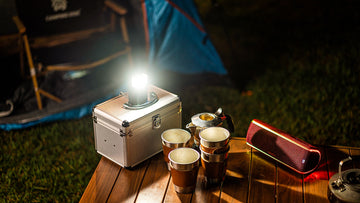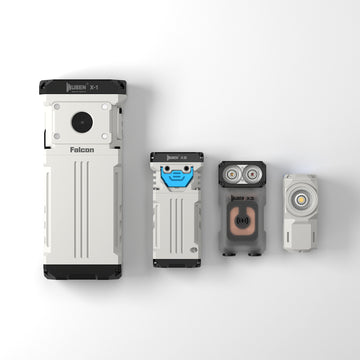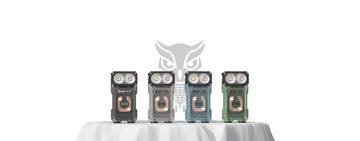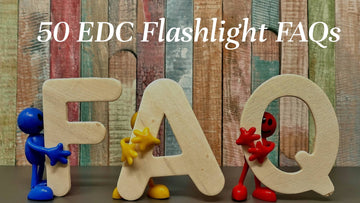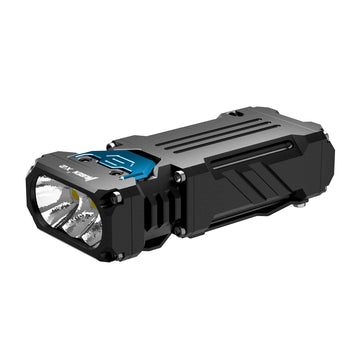
Flashlights are indispensable tools in our lives, providing portable and reliable sources of light in various situations. But have you ever wondered how these seemingly simple devices work? In this article, we will explore the inner workings of flashlights, the components that make them function, and the mechanisms that enable them to emit light. So, let's dive into the fascinating world of flashlight technology and discover the science behind their operation.
To understand how flashlights work, it's essential to familiarize ourselves with their key components, each playing a crucial role in the overall functionality of the device.
Bulb or LED
The bulb or LED (Light-Emitting Diode) is the heart of a flashlight, responsible for generating light. In traditional incandescent flashlights, a small, high-resistance wire filament is heated by passing an electric current through it, causing it to emit light. On the other hand, modern LED flashlights utilize solid-state lighting technology, where electrical current passes through a semiconductor, producing light more efficiently.
Reflectors and Lenses
Reflectors and lenses work together to shape and direct the light emitted from the bulb or LED. Reflectors are designed to gather and focus the light in a specific direction, maximizing its output. Lenses, often made of glass or plastic, help to enhance the beam's clarity, allowing for better focus or diffusion depending on the flashlight's design.
Batteries and Power Source
Flashlights require a power source to function, and most commonly, this comes in the form of batteries. The batteries, such as alkaline or rechargeable variants, supply the electrical energy needed to power the flashlight. The battery compartment is designed to hold and connect the batteries, completing the electrical circuit.
Switch and Circuitry
The switch is the interface that controls the flow of electricity within the flashlight. When the switch is turned on, it completes the circuit, allowing the electrical current to flow from the battery through the components, ultimately powering the bulb or LED. The circuitry within the flashlight ensures a smooth and stable flow of electricity, preventing fluctuations or damage to the components.
Now that we understand the key components, let's explore the working mechanism of a flashlight.
When the switch is turned on, it allows electrical current to flow from the battery through the circuitry. The battery acts as the power source, providing the necessary voltage to drive the flashlight's operation.
In incandescent flashlights, the electrical current heats the filament, causing it to glow and emit light due to its high resistance. In LED flashlights, the electrical current passes through a semiconductor material, exciting electrons and causing them to emit photons, producing visible light. This process is highly efficient and results in a brighter and longer-lasting light output compared to traditional incandescent bulbs.
The reflector behind the bulb or LED helps to concentrate the emitted light, directing it in a specific direction. The shape and design of the reflector influence the flashlight's beam pattern, such as spot or flood. Lenses, positioned in front of the bulb or LED, further manipulate the light by focusing or diffusing it, providing different lighting effects based on the intended use of the flashlight.
Flashlights come in various types, each offering unique features and benefits.
Incandescent Flashlights
Traditional incandescent flashlights are characterized by their filament-based bulbs. They are simple and inexpensive but tend to have shorter battery life and produce less light output compared to LED flashlights.
LED Flashlights
LED flashlights have gained significant popularity in recent years due to their efficiency, durability, and superior light output. They consume less power, resulting in longer battery life, and their solid-state lighting technology allows for brighter illumination. LED flashlights also come in various designs, including tactical, keychain, and rechargeable options.
Other Specialized Flashlights
In addition to incandescent and LED flashlights, there are specialized flashlights designed for specific applications. These include ultraviolet (UV) flashlights used for detecting stains or counterfeit money, infrared (IR) flashlights for night vision purposes, and underwater flashlights for diving or marine activities.
To understand how flashlights work, it's essential to familiarize ourselves with their key components, each playing a crucial role in the overall functionality of the device.
Bulb or LED
The bulb or LED (Light-Emitting Diode) is the heart of a flashlight, responsible for generating light. In traditional incandescent flashlights, a small, high-resistance wire filament is heated by passing an electric current through it, causing it to emit light. On the other hand, modern LED flashlights utilize solid-state lighting technology, where electrical current passes through a semiconductor, producing light more efficiently.
Reflectors and Lenses
Reflectors and lenses work together to shape and direct the light emitted from the bulb or LED. Reflectors are designed to gather and focus the light in a specific direction, maximizing its output. Lenses, often made of glass or plastic, help to enhance the beam's clarity, allowing for better focus or diffusion depending on the flashlight's design.
Batteries and Power Source
Flashlights require a power source to function, and most commonly, this comes in the form of batteries. The batteries, such as alkaline or rechargeable variants, supply the electrical energy needed to power the flashlight. The battery compartment is designed to hold and connect the batteries, completing the electrical circuit.
Switch and Circuitry
The switch is the interface that controls the flow of electricity within the flashlight. When the switch is turned on, it completes the circuit, allowing the electrical current to flow from the battery through the components, ultimately powering the bulb or LED. The circuitry within the flashlight ensures a smooth and stable flow of electricity, preventing fluctuations or damage to the components.
Now that we understand the key components, let's explore the working mechanism of a flashlight.
When the switch is turned on, it allows electrical current to flow from the battery through the circuitry. The battery acts as the power source, providing the necessary voltage to drive the flashlight's operation.
In incandescent flashlights, the electrical current heats the filament, causing it to glow and emit light due to its high resistance. In LED flashlights, the electrical current passes through a semiconductor material, exciting electrons and causing them to emit photons, producing visible light. This process is highly efficient and results in a brighter and longer-lasting light output compared to traditional incandescent bulbs.
The reflector behind the bulb or LED helps to concentrate the emitted light, directing it in a specific direction. The shape and design of the reflector influence the flashlight's beam pattern, such as spot or flood. Lenses, positioned in front of the bulb or LED, further manipulate the light by focusing or diffusing it, providing different lighting effects based on the intended use of the flashlight.
Flashlights come in various types, each offering unique features and benefits.
Incandescent Flashlights
Traditional incandescent flashlights are characterized by their filament-based bulbs. They are simple and inexpensive but tend to have shorter battery life and produce less light output compared to LED flashlights.
LED Flashlights
LED flashlights have gained significant popularity in recent years due to their efficiency, durability, and superior light output. They consume less power, resulting in longer battery life, and their solid-state lighting technology allows for brighter illumination. LED flashlights also come in various designs, including tactical, keychain, and rechargeable options.
Other Specialized Flashlights
In addition to incandescent and LED flashlights, there are specialized flashlights designed for specific applications. These include ultraviolet (UV) flashlights used for detecting stains or counterfeit money, infrared (IR) flashlights for night vision purposes, and underwater flashlights for diving or marine activities.
Tags:
Related Articles

